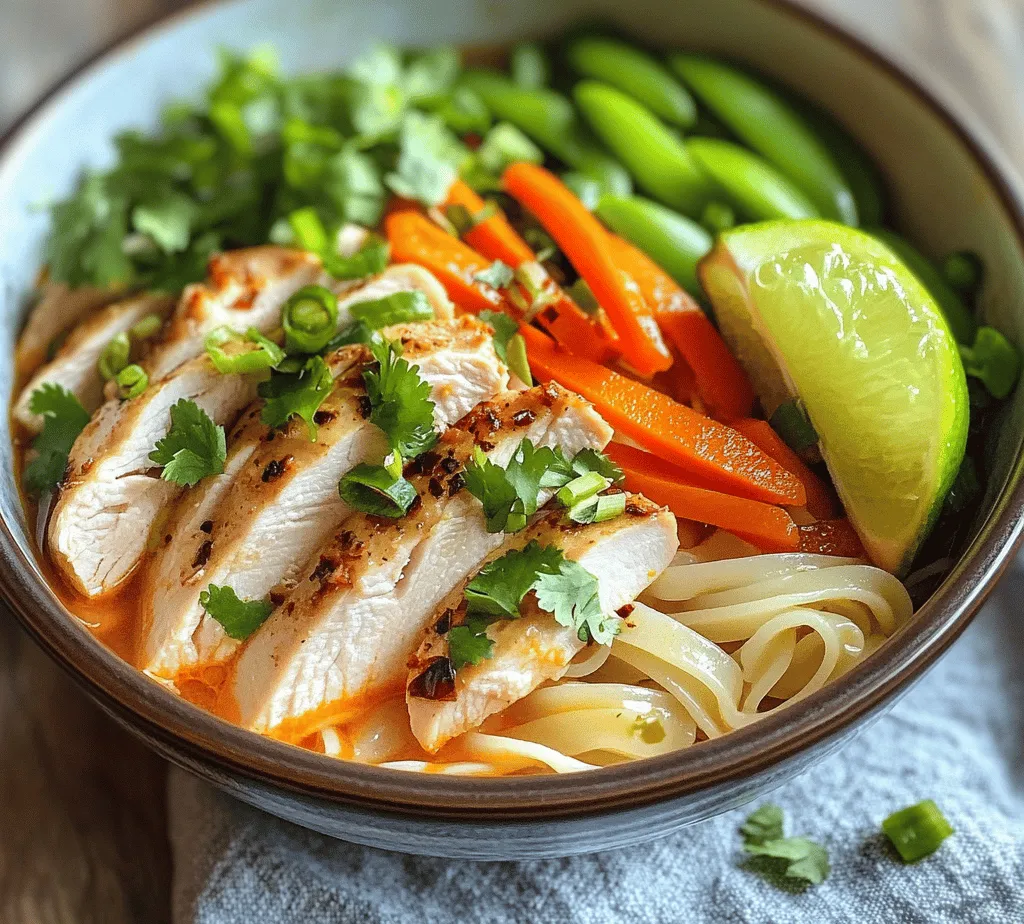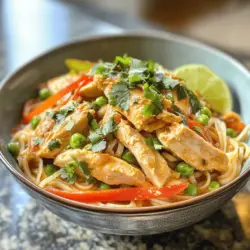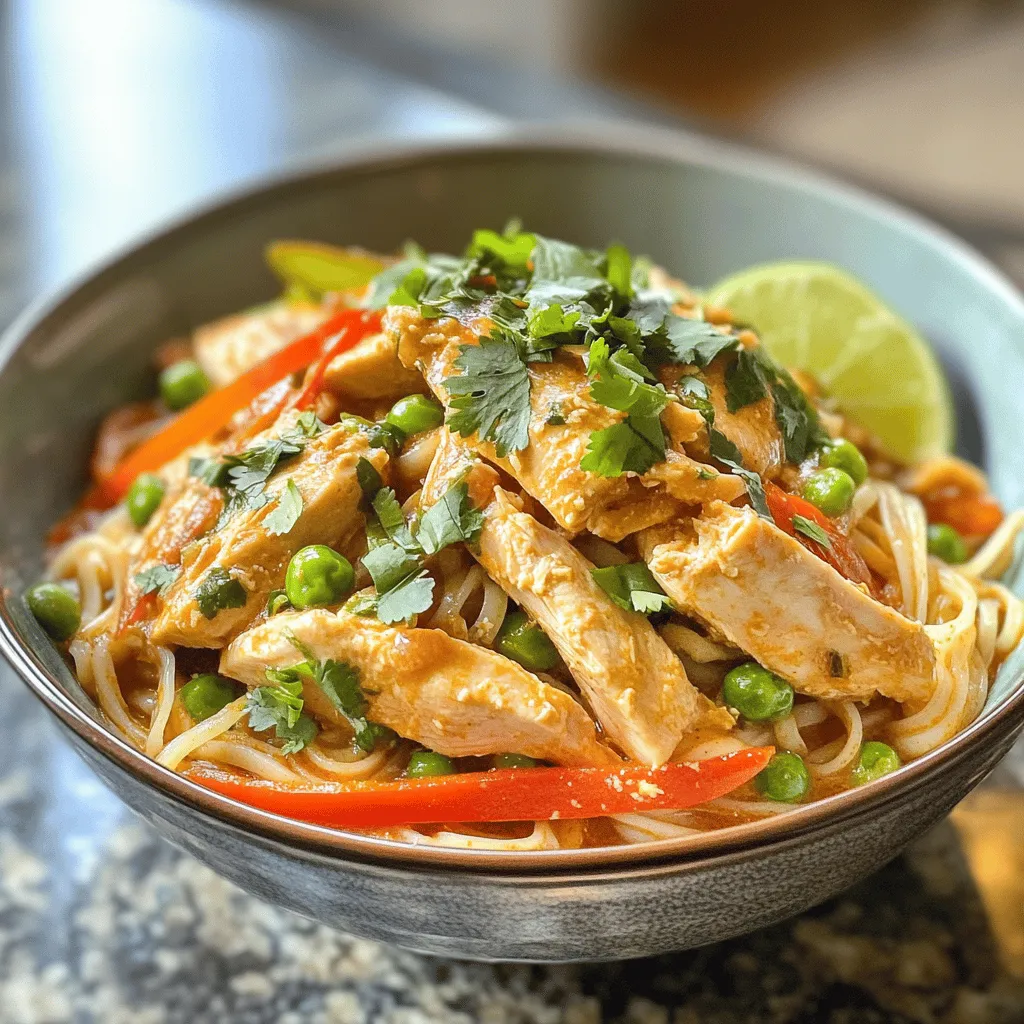Introduction to Thai Chicken Noodle Soup
If you’re looking to excite your taste buds while maintaining a busy schedule, the 30 Minute Thai Chicken Noodle Soup is your answer. This recipe encapsulates the vibrant and aromatic essence of Thai cuisine, making it a delightful addition to your weeknight dinner rotation. In just half an hour, you can whip up a bowl of comforting soup that combines tender chicken, an array of colorful vegetables, and an aromatic blend of spices—all enveloped in a creamy coconut broth. This dish not only satisfies your hunger but also brings together a medley of flavors that are sure to impress your family and friends.
Thai Chicken Noodle Soup is more than just a meal; it’s a culinary experience steeped in tradition. Thai cuisine is renowned for its balance of flavors—sweet, salty, sour, and spicy—and this soup embodies that balance perfectly. The use of fresh ingredients, such as herbs and spices, highlights the importance of quality in Thai cooking. As you prepare this dish, you’ll appreciate the harmony of its components, from the richness of coconut milk to the bright crunch of vegetables.
In this article, we will explore not just how to make this delicious soup but also the significance of each ingredient and how they contribute to the overall dish. We’ll break down the essential ingredients, discuss their nutritional benefits, and guide you through the preparation steps to ensure that your Thai Chicken Noodle Soup is a flavorful success.
Understanding the Ingredients
Essential Components of Thai Chicken Noodle Soup
To create a truly authentic and satisfying Thai Chicken Noodle Soup, you’ll need to gather a few key ingredients. Understanding the role of each component will help you appreciate the dish even more.
- Chicken: The primary protein in this soup, chicken can be used in various forms, but chicken thighs are often preferred for their tenderness and juiciness. They provide a richer flavor compared to chicken breasts, which can dry out more easily during cooking.
- Vegetables: Fresh vegetables not only add nutrition but also enhance the soup’s flavor and texture. Bell peppers and snap peas are common choices for this recipe. Bell peppers contribute a subtle sweetness and vibrant color, while snap peas lend a delightful crunch that contrasts beautifully with the creamy broth.
- Noodles: Rice noodles are typically used in Thai soups, providing a satisfying chewiness that absorbs the flavors of the broth. They’re quick to cook, making them ideal for this 30-minute recipe.
- Coconut Milk: This ingredient is crucial for creating the rich, creamy base of the soup. Coconut milk adds a subtle sweetness and a velvety texture that complements the spices and other flavors seamlessly.
- Spices: The aromatic profile of the soup comes from key spices such as red curry paste, fish sauce, and soy sauce. The red curry paste brings a warm heat and complexity, while fish sauce adds a salty umami flavor that rounds out the dish. Soy sauce enhances the depth of flavor without overpowering the other ingredients.
Nutritional Benefits
In addition to being delicious, this Thai Chicken Noodle Soup is also packed with nutritional benefits, making it a wholesome choice for dinner.
- Chicken Thighs vs. Chicken Breasts: While both cuts of chicken are nutritious, chicken thighs are often richer in vitamins and minerals. They contain more iron and zinc, which are essential for maintaining healthy immune function. Plus, the extra fat in thighs can contribute to a more satisfying meal.
- Fresh Vegetables: Incorporating a variety of colorful vegetables not only makes the soup visually appealing but also boosts its nutritional profile. Bell peppers are high in vitamin C, which is vital for immune health and skin integrity. Snap peas provide fiber, vitamins A and C, and antioxidants, promoting overall well-being.
- Coconut Milk: While coconut milk is higher in calories compared to other dairy alternatives, it offers numerous health benefits. It contains medium-chain triglycerides (MCTs), which may improve metabolism and provide a quick source of energy. Additionally, coconut milk is lactose-free, making it suitable for those with dairy intolerances.
Preparation Steps
Step-by-Step Cooking Instructions
Now that we’ve covered the ingredients and their significance, it’s time to dive into the preparation of your Thai Chicken Noodle Soup. Follow these detailed steps for a successful and flavorful outcome.
1. Heat the Coconut Oil: Start by heating a tablespoon of coconut oil in a large pot over medium heat. Coconut oil not only contributes to the flavor but also helps in cooking the chicken, allowing it to brown nicely.
2. Cook the Chicken: Once the oil is hot, add bite-sized pieces of chicken thighs to the pot. Sauté them until they are golden brown and fully cooked, about 5-7 minutes. This step is crucial for building the soup’s flavor base.
3. Sauté Aromatics: After the chicken is cooked, push it to one side of the pot and add minced garlic and ginger to the other side. Sauté them for about 1-2 minutes until fragrant. Garlic and ginger are essential in Thai cuisine, providing not only flavor but also health benefits, such as anti-inflammatory properties.
4. Add Vegetables: Next, add your sliced bell peppers and snap peas to the pot. Sauté them alongside the chicken and aromatics for another 2-3 minutes. You want the vegetables to be tender yet still crisp, preserving their vibrant colors and nutrients.
Creating the Soup Base
With the chicken and vegetables sautéed to perfection, it’s time to create the soup base that will bring all these flavors together.
1. Add Coconut Milk and Broth: Pour in a can of coconut milk and equal parts chicken broth or stock, stirring well to combine. The coconut milk will create a creamy texture, while the broth adds depth to the flavor profile.
2. Simmer for Flavor Development: Increase the heat and bring the mixture to a gentle simmer. Let it cook for about 5 minutes, allowing the flavors to meld together beautifully. This simmering process is essential for developing the rich flavors that characterize Thai Chicken Noodle Soup.
3. Balance the Flavors: Taste the broth and add in the red curry paste, fish sauce, and soy sauce. Adjust the quantities based on your spice tolerance and flavor preference. If you enjoy a bit more heat, feel free to add extra curry paste. If you prefer a sweeter broth, a dash of sugar can help balance the flavors.
Cooking the Noodles
Finally, it’s time to prepare the noodles that will complete your soup.
1. Prepare Rice Noodles: In a separate pot, bring water to a boil and cook the rice noodles according to package instructions. Typically, they take about 5-7 minutes to cook. Make sure not to overcook them, as they will continue to soften when added to the soup.
2. Combine Everything: Once the noodles are cooked, drain them and add them directly to the pot with the soup base. Let them soak in the flavorful broth for a minute or two, allowing them to absorb some of the deliciousness.
With these steps, your 30 Minute Thai Chicken Noodle Soup is nearly complete. The combination of tender chicken, fresh vegetables, and creamy coconut broth will create a dish that is both satisfying and nourishing. As you prepare to serve, consider garnishing with fresh herbs like cilantro or basil to enhance the flavors even further.
Stay tuned for the next part of this article, where we will explore tips for achieving the best results and answer some common questions about this delicious recipe.

Different Types of Noodles: Rice vs. Egg Noodles
When preparing your 30 Minute Thai Chicken Noodle Soup, one of the most significant decisions you will make involves the type of noodles to use. The two most common varieties, rice noodles and egg noodles, each bring their unique texture and flavor to the dish.
Rice Noodles: A staple in many Asian cuisines, rice noodles are gluten-free and have a delicate texture that absorbs flavors beautifully. They come in various widths, ranging from thin vermicelli to wider flat noodles. Rice noodles are typically soft and chewy when cooked correctly, making them an excellent vehicle for soups.
Egg Noodles: These noodles are made with wheat flour and eggs, giving them a slightly richer flavor and a firmer texture compared to rice noodles. Egg noodles hold their shape well and provide a heartier bite, making them a popular choice for many noodle soups.
Tips for Cooking Noodles to Achieve the Ideal Texture
To ensure that your noodles enhance your Thai Chicken Noodle Soup rather than detract from it, pay attention to the following tips:
1. Cook Separately: For the best texture, consider cooking your noodles separately from the soup. Boil them according to package instructions, then drain and rinse them under cold water to stop the cooking process. This prevents them from becoming mushy when added to the hot soup.
2. Timing is Key: Rice noodles typically cook faster than egg noodles. For rice noodles, soak them in hot water for about 10-15 minutes until they soften, then drain. For egg noodles, follow the package instructions, usually around 6-8 minutes in boiling water.
3. Al Dente Finish: Aim for an al dente texture, meaning the noodles should have a slight bite to them. This will ensure they don’t become overly soft when combined with the soup.
4. Add Last: If cooking the noodles directly in the soup, add them during the final few minutes of cooking. This ensures they will soak up the flavors of the broth without losing their desired texture.
Combining Ingredients for Maximum Flavor
Now that you’ve prepared your noodles, it’s time to integrate them into your Thai Chicken Noodle Soup for a harmonious blend of flavors.
1. Layering Flavors: Start by sautéing aromatics like garlic and ginger in your pot before adding the broth. This technique helps to release their essential oils and creates a fragrant base for your soup.
2. Adjust Cooking Times: Consider the cooking times of your chicken and vegetables. For example, if you prefer your vegetables to maintain some crunch, add them to the broth after the chicken has cooked through. Allow them to simmer just long enough to soften while retaining their vibrant color.
3. Finish with Fresh Ingredients: To enhance freshness, add ingredients like scallions, cilantro, or Thai basil at the end of cooking. This not only adds flavor but also a beautiful presentation.
Serving Suggestions
Presentation Tips
A well-presented dish enhances the dining experience, and your Thai Chicken Noodle Soup is no exception. Here are some creative ways to garnish your soup for visual appeal:
- Herb Garnish: Top your soup with freshly chopped herbs, such as cilantro or Thai basil, to add a splash of color and freshness.
- Chili Oil or Slices: A drizzle of chili oil or a few slices of fresh red chili can provide a pop of color and a hint of heat.
- Lime Wedges: Serve with lime wedges on the side. The bright green color adds vibrancy and invites diners to customize their flavor.
Lime Juice for Brightness and Balance: A squeeze of lime juice just before serving can elevate your soup by adding a refreshing acidity that balances the richness of the broth and the fat in the chicken. This simple addition can transform the overall flavor profile, enhancing the authenticity of your dish.
Pairing with Side Dishes
To create a complete meal experience, consider these complementary side dishes or appetizers:
- Spring Rolls: Fresh or fried spring rolls filled with vegetables or shrimp pair excellently with the soup, providing a crisp contrast to the warm broth.
- Thai Salad: A light Thai salad with a tangy dressing can refresh the palate between spoonfuls of soup.
- Coconut Rice: For a hearty side, serve your soup with coconut rice. The creamy, slightly sweet rice complements the savory flavors of the soup.
Beverage Pairings: Enhance your dining experience with carefully chosen beverages. A light lager or a refreshing Thai iced tea can soothe the palate. Alternatively, for a non-alcoholic option, try a sparkling water with lime for a crisp and refreshing contrast.
Cultural Context of Thai Chicken Noodle Soup
Traditional Thai Soup Varieties
Thai cuisine is rich with diverse soup options, each with its unique flavor profile and ingredients. Popular varieties include:
- Tom Yum: A hot and sour soup, usually made with shrimp or chicken, known for its bold flavors from lemongrass, kaffir lime leaves, and galangal.
- Tom Kha: A coconut milk-based soup that is both creamy and fragrant, often featuring chicken, mushrooms, and herbs.
These soups, while different from Thai Chicken Noodle Soup, share a common foundation of aromatic herbs and spices, showcasing the essence of Thai cooking.
The Influence of Thai Cuisine Worldwide
Thai cuisine has made a significant impact on global culinary scenes, celebrated for its balance of flavors—sweet, sour, salty, and spicy. The accessibility of Thai ingredients and recipes has led to the growing popularity of Thai cooking in home kitchens around the world. People are increasingly experimenting with Thai flavors, creating fusion dishes that blend traditional techniques with local ingredients.
Conclusion: Enjoying Your Thai Chicken Noodle Soup Experience
In conclusion, this 30 Minute Thai Chicken Noodle Soup not only offers a quick and delicious meal but also serves as a gateway to the rich and vibrant world of Thai cuisine. With its harmonious blend of flavors and textures, this recipe is perfect for both novice cooks and seasoned chefs looking to explore new culinary horizons. Enjoy this comforting dish and share it with loved ones to create memorable dining experiences. The delightful aroma, vibrant colors, and balanced flavors of your Thai Chicken Noodle Soup will undoubtedly become a favorite in your home, making it a dish you return to time and time again.


